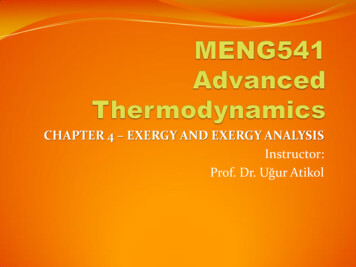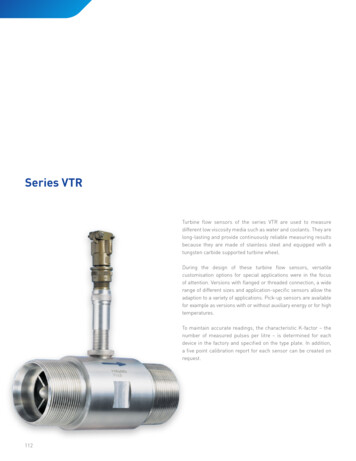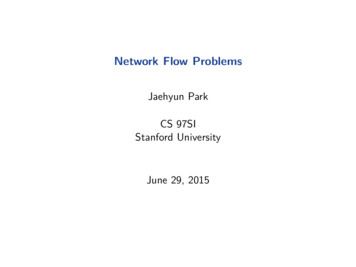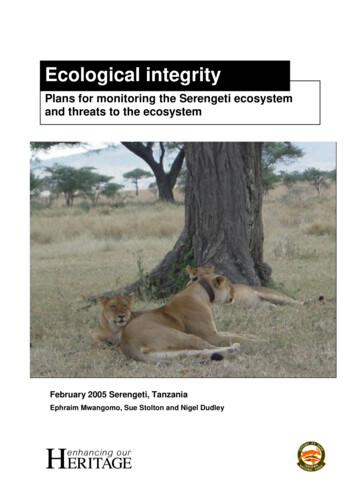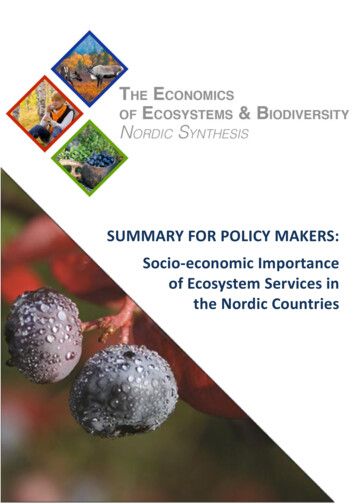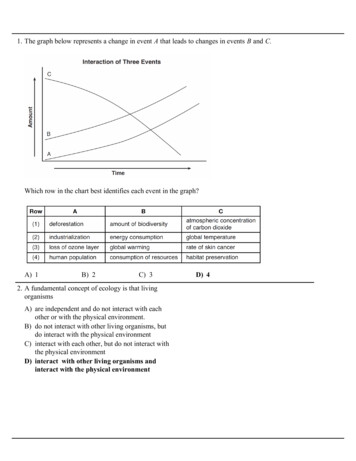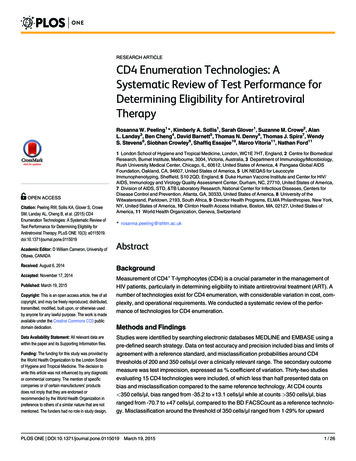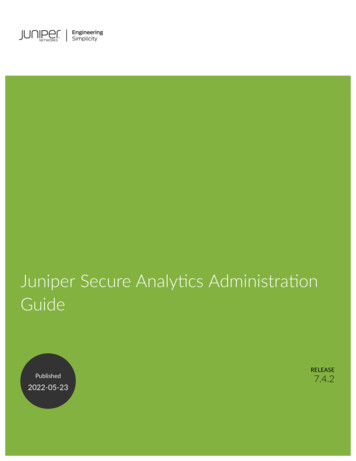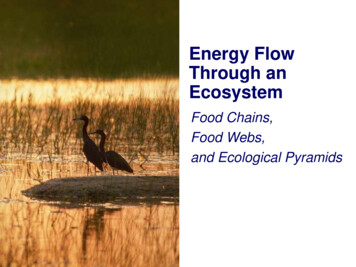
Transcription
Energy FlowThrough anEcosystemFood Chains,Food Webs,and Ecological Pyramids
What is Ecology?ECOLOGY is a branch ofbiology that studiesecosystems.
Ecological Terminology EnvironmentEcologyBiotic vs. AbioticPopulationCommunityEcosystemBiosphere
Environment – surroundings of an organism includingthe plants, animals and microbes with which itinteracts. Ecology – study of how living organisms interact withthe physical and biological environments. Abiotic - non-living chemical and physical factors ofthe environment (e.g. temperature, light, water, soil,nutrients). Biotic – living organisms that are part of theenvironment.
Population – a group of individuals of the samespecies living in the same geographic area. Community – all interacting populations living in thesame geographic area. Ecosystem – all interacting communities of organismsand abiotic factors of the environment within a definedarea. Biosphere – the global ecosystem, including all theearth’s regions that can support life (land, air, water).
The3-StepENERGYPathway ofEcosystems
ENERGY in the ecosystemENERGY !BEGINS WITH SUNLIGHT
LIGHT1.CHEMICALENERGY2.HEAT3.
photosynthesisCO2 H2OC6H12O6 O2GLUCOSEchemicalenergy
The chemical reaction by which greenplants use water and carbon dioxide andlight from the sun to make glucose. ENERGY is stored in glucose; glucose isstored as starch.
respirationGlucoseO2 C6H12O6CO2 H2Owork forcellsHEAT
6O2 C6H12O6 6H2O 6CO2 energyCELLULAR RESPIRATION is thechemical reaction that releases theenergy in glucose so the cell cando work.
Note: although the vast majority are, some ecosystems are notbased around solar energy.For example, some organisms are able to usesulfur from hydrothermal vents as a source of energy.
FOOD CHAINSandTROPHIC LEVELS
Organisms that can makeglucose duringphotosynthesis are calledPRODUCERS.
Organisms that cannot make theirown glucose are calledCONSUMERS.
The transfer of energy fromsun to producer to consumerscan be shown in a FOODCHAIN.
A food chain(follow the ENERGYcoming from the SUN)
A food chain1PRODUCERS(autotrophs capture ENERGYcoming from the SUN)
A food chain1PRODUCERS2Primary consumers(herbavores that get ENERGY& MATERIALS from thePRODUCERS they eat)
A food chain1PRODUCERS2Primary consumers3Secondary Consumers(carnivores that get ENERGY& MATERIALS from theHERBIVORES they eat)
A food chain1PRODUCERS2Primary consumers3Secondary Consumers4Tertiary Consumers
the numbersare called1Trophic levels234
trophic levels12Notice that thearrows point in thedirection ofenergy flow.tell how far awayeach feeding levelis fromTHE SUN34
54321
THE 10% RULEandECOLOGICAL PYRAMIDS
The maximum amount ofENERGY that passes from onetrophic level to the next isusually around 10%.About 90% of the ENERGY ateach trophic level is usedto keep the organisms alive andis converted to HEAT.
Where does the energy go?Energy from lower trophic levelGross energy intakeEnergy not used10 %90%Egested energyDigested energyAssimilated energyUrinary wasteResting energyActivity Growth ReproductionMaintenance orrespirationProduction
Where does the energy go?Energy from lower trophic levelEnergy not used10 %Gross energy intakeDigested energyUrinary wasteResting energyAssimilated energyActivity Growth Reproduction
Where does the energy go?Energy from lower trophic levelEnergy not usedand available to bepassed to the nextlevelUrinary wasteResting energyGross energy intakeDigested energyAssimilated energyActivity Growth Reproduction
Always startwith the SUN.
PRODUCERSHERBIVORES1st OrderCARNIVORESProducers are the BASEof the energy pyramidbecause2nd Ordertheir ENERGY comes directCARNIVORESfrom the SUN.3rd OrderCARNIVORES
Producers use most of theenergy they make (90%) forthemselves.
The 10% of energy that is notused by producers can bepassed on to organisms thatcannot make their own energy.
PRODUCERSPrimary Consumers1st OrderCARNIVORESHERBIVORES2nd Orderexist ononly 10%CARNIVORESof the ENERGY thatPRODUCERS3rdacquire.OrderCARNIVORES
Most (90%) of the energy theprimary consumer gets from theproducer is used by theconsumer.
Some of the energy movesinto the atmosphere as heat.
Some energy in the primaryconsumer is not lost to theatmosphere or used by theconsumer itself.This 10% of energy is availablefor another consumer.
PRODUCERSPrimary ConsumersSecondaryConsumers2nd OrderCARNIVORES3rdCarnivoresOrder get only 10%CARNIVORESof the HERBIVORES energy intake.
Most (90%) of the energy thesecondary consumer gets fromthe primary consumer is used bythe secondary consumer.
Some of the energy is lost asheat, but some (10%) energyis stored and can passed onto another consumer.
PRODUCERSPrimary ConsumersSecondaryConsumersTertiaryConsumers3rd OrderCARNIVORESThere isn’t muchENERGY left near the top.
PRODUCERSPrimary ConsumersThe 10%RULE . . umers.resultsin thisEcologicalPYRAMID
Ecological pyramids show: That the amount ofavailable energydecreases down the foodchain It takes a large number ofproducers to support asmall number of primaryconsumers It takes a large number ofprimary consumers tosupport a small numberof secondary consumers
There are three types of Ecological Pyramids1.Pyramid of Numbers2.Pyramid of Biomass3.Pyramid of Energy
Pyramid of NumbersShows thenumber oforganisms ateach trophiclevel.
Pyramids of numbers will often bepyramid-shaped - but not always. If the producer is alarge plant such as anoak tree, the secondlayer of the pyramidrepresenting primaryconsumers (caterpillarsin this example) will bemuch larger than thebase. In this case itwould make moresense to draw apyramid of biomass.
Pyramid of BiomassShows the totalmass of livingtissue at eachlevel e.g.shows that alarge amountof tree massis needed tofeed a singlecaterpillar.
Pyramid of Biomass Units are in mass per unit area. For example:– g/M2 “grams per square meter”
Example Pyramid of Biomass
The 10% rule applies toPyramids of Biomass
1 lb.For every 1 lb. ofhalibut, how manylbs. of sealscan be supported ?
1 lb.For every 1 lb. ofhalibut, 0.1 lbs.of sealcan be supported !0.1 lbs
30,000For a 30 lb.halibut, 30,000 lbs.of phytoplanktonlbs. are necessary !3,000 lbs.300 lbs.30 lbs.2nd Order CARNIVORES
Pyramid of Energy– shows the total amount of incoming energy ate eachsuccessive level– based on the idea that 90% of the energy is lost asheat at each trophic level and only 10% of the energyis passed on.
Pyramid of Energyenergy units are in joules (J) or Kilocalories (kcal)
FOOD WEBS !Show all the possible FOOD CHAINS.Show all the OMNIVORES.Show multiple feeding preferences.
Typically decomposers(saprotrophs and detritovores)are placed beneathproducers in the food web
Oooops !What’s wrongwith this foodweb ?
Oooops !What’s wrongwith this foodweb ?1. No producers.2. Arrows pointbackwards.
The End!
Ecology - study of how living organisms interact with the physical and biological environments. Abiotic - non-living chemical and physical factors of the environment (e.g. temperature, light, water, soil, nutrients). Biotic - living organisms that are part of the environment.
